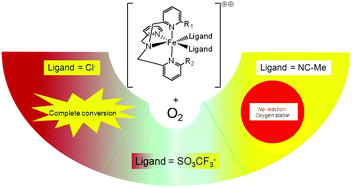Structural bases of oxygen-sensitivity in Fe(ii) complexes with tripodal ligands. Steric effects, Lewis acidity and the role of ancillary ligands†
Abstract
The complexation of Fe(SO3CF3)2 to the series of

Maintenance work is planned for Wednesday 1st May 2024 from 9:00am to 11:00am (BST).
During this time, the performance of our website may be affected - searches may run slowly and some pages may be temporarily unavailable. If this happens, please try refreshing your web browser or try waiting two to three minutes before trying again.
We apologise for any inconvenience this might cause and thank you for your patience.
* Corresponding authors
a
Laboratoire de Chimie Biomimétique des Métaux de Transition, UMR CNRS n° 7177, Institut de Chimie de Strasbourg et Université de Strasbourg, Bâtiment Le Bel, 4 rue Blaise Pascal, CS 90032, F-67081 Strasbourg cedex, France
E-mail:
mandon@unistra.fr
Fax: +33-(0)368-851-438
Tel: +33-(0)368-851-537
b Laboratoire d'Ingénierie des Matériaux Organométalliques et Moléculaires, Unité associée au CNRST URAC 19, Université Sidi Mohamed Ben Abdellah, Faculté des Sciences, BP 1796 (Atlas), 30000 Fez, Morocco
c Service de Radiocristallographie, UMR CNRS n° 7177, Institut de Chimie de Strasbourg et Université de Strasbourg, 1, rue Blaise Pascal, BP 296/R8 67008 Strasbourg cedex, France
The complexation of Fe(SO3CF3)2 to the series of

 Please wait while we load your content...
Something went wrong. Try again?
Please wait while we load your content...
Something went wrong. Try again?
L. Benhamou, A. Thibon, L. Brelot, M. Lachkar and D. Mandon, Dalton Trans., 2012, 41, 14369 DOI: 10.1039/C2DT31558K
To request permission to reproduce material from this article, please go to the Copyright Clearance Center request page.
If you are an author contributing to an RSC publication, you do not need to request permission provided correct acknowledgement is given.
If you are the author of this article, you do not need to request permission to reproduce figures and diagrams provided correct acknowledgement is given. If you want to reproduce the whole article in a third-party publication (excluding your thesis/dissertation for which permission is not required) please go to the Copyright Clearance Center request page.
Read more about how to correctly acknowledge RSC content.
 Fetching data from CrossRef.
Fetching data from CrossRef.
This may take some time to load.
Loading related content
